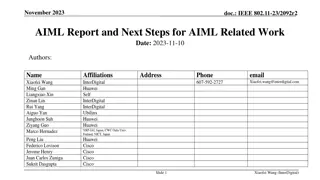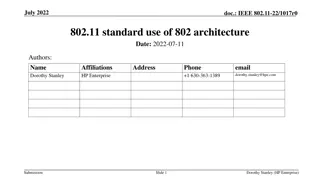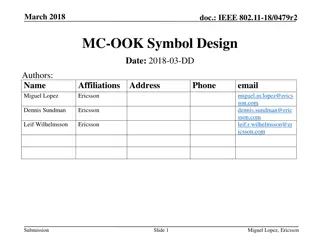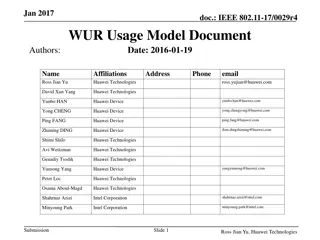Understanding IEEE 802.11-22/2083r1 Wake-Up Radio (WUR) and MC-OOK Signals
The document explores the IEEE 802.11-22/2083r1 specifications regarding Wake-Up Radio (WUR) PHY, focusing on WUR PPDU reception requirements and the use of multicarrier on-off keying (MC-OOK) signals. It examines the ambiguity surrounding MC-OOK in WUR PPDU compositions, emphasizing the need for clarity to guide implementers effectively. The content delves into WUR non-AP STA obligations, transmit requirements for WUR PPDU, and associated standards. It includes slides reviewing relevant clauses, MC-OOK details, proposed CID resolutions, and straw polls for resolving outstanding issues.
Download Presentation

Please find below an Image/Link to download the presentation.
The content on the website is provided AS IS for your information and personal use only. It may not be sold, licensed, or shared on other websites without obtaining consent from the author. Download presentation by click this link. If you encounter any issues during the download, it is possible that the publisher has removed the file from their server.
E N D
Presentation Transcript
doc.: IEEE 802.11-22/2083r1 November 2022 Re WUR, MC-OOK, and multicarrier signals Date: 2022-12-06 Name Affiliation Address Phone email 9120 Irvine Center Drive, Ste.200, Irvine, CA 92618, USA Se n Coffey Realtek +1 (415) 572-6221 coffey@realtek.com CIDs addressed: LB 270 CIDs 3067-3068, 3070-3072, 3095-3096, 3278, 3283, 3458 r0 (November 30, 2022): Initial draft r1 (December 6, 2022): Added CID 3278; added extra slides at end discussing ways forward, with candidate straw polls. Submission Slide 1 Sean Coffey, Realtek
doc.: IEEE 802.11-22/2083r1 November 2022 Abstract Clause 30 (Wake-Up Radio PHY specification) requires a WUR non-AP STA to be able to receive WUR PPDUs at given power levels. But what is a WUR PPDU? This is not clear. In particular: 1. A WUR PPDU contains a component that is called MC-OOK 2. MC-OOK stands for multicarrier on-off keying 3. But the normative requirements say only that MC-OOK should be generated as (one kind of) a multicarrier signal implying that other choices are permissible 4. Other sections say that MC-OOK is a multicarrier signal, but without corresponding normative language saying that it shall be 5. WUR non-AP STAs are required to be able to receive any compliant WUR PPDU, including PPDUs that do not follow the multicarrier format even though the spec strongly suggests that this is the only format required to be received It is essential for the specification to provide adequate notice to potential implementers on what is required of a compliant portion; the current draft does not do this. Submission Slide 2 Sean Coffey, Realtek
doc.: IEEE 802.11-22/2083r1 November 2022 Summary Slides 4-6 review what is (or seems to be) required under the spec as it is Slides 7-9 review MC-OOK and its associated should statements Slides 10-11 review MC-OOK and multicarrier and their associated descriptive statements Slide 12 reviews Annex AC Slides 13-22 review the CIDs and the proposed resolutions Slides 23-26 provide straw polls that may help clarify which direction to take to resolve all CIDs except CID 3278 Slides 27-28 discuss CID 3278 Note for slides 4-12, cf. doc. IEEE 802.11-22/1035r1, Proposed TGme Comment Resolution CID 2346 , J. Levy, September 2022 (similar and consistent, but not identical) Submission Slide 3 Sean Coffey, Realtek
doc.: IEEE 802.11-22/2083r1 November 2022 Requirements I A WUR non-AP STA is required to be able to receive WUR PPDUs at given power levels: (D2.0 4608) Other WUR non-AP STA requirements are in the following subclauses (adjacent channel rejection, nonadjacent channel rejection, receiver maximum input level, CCA sensitivity) Submission Slide 4 Sean Coffey, Realtek
doc.: IEEE 802.11-22/2083r1 November 2022 Requirements II A WUR PPDU is required to satisfy several transmit requirements (D2.0 4604 ): 30.3.12 WUR transmit specification 30.3.12.1 Transmit spectrum mask For operation using 20 MHz channel spacing, the transmitted spectrum of the WUR-Sync and WUR-Data fields shall have a 0 dBr [ ] bandwidth The transmitted spectral density of the WUR-Sync and WUR-Data fields of the transmitted signal shall fall within the spectral mask [Similar requirements for 40 MHz, 80 MHz, & preambles] 30.3.12.2 Spectral flatness The requirement is that the power in any 1 MHz segment, within the center 4 MHz, is in the range of [Pave 6 dB, Pave + 3 dB] 30.3.12.3 Transmit center frequency and symbol clock frequency tolerance The symbol clock frequency and transmit center frequency tolerance shall be 20 ppm maximum. The transmit center frequency and the symbol clock frequency for all transmit antennas and frequency segments shall be derived from the same reference oscillator. Submission Slide 5 Sean Coffey, Realtek
doc.: IEEE 802.11-22/2083r1 November 2022 Requirements III Transmit requirements, contd.: 30.3.12.4 Transmit On and Off Symbols power ratio For each input bit of the WUR-Data field transmitted at WUR HDR, the ratio between the averaged power of the On Symbol and the averaged power of the Off Symbol of the transmit signal in the WUR-Data field shall be at least 20 dB. For each input bit of the WUR-Data field transmitted at WUR LDR, the ratio between the averaged power over On Symbols and the averaged power over Off Symbols of the transmit signal in the WUR-Data field shall be at least 20 dB. For the WUR-Sync field transmission, the ratio between the averaged power over all On Symbols and the averaged power over all Off Symbols in the WUR-Sync field shall be at least 20 dB. For FDMA transmission, the above requirement on the transmit On and Off Symbols power ratio applies to each 20 MHz channel. It seems that these are the only shall requirements on the transmitted signal. Note that none of these requirements refer to a multicarrier format. Submission Slide 6 Sean Coffey, Realtek
doc.: IEEE 802.11-22/2083r1 November 2022 MC-OOK should statements I 30. Wake-Up Radio (WUR) PHY specification(11ba) 30.1 Introduction The multicarrier signal should be generated using contiguous 13 subcarriers, centered within a 20 MHz channel, with a subcarrier spacing of 312.5 kHz and the center subcarrier (#1131)being null. The subcarrier coefficients may take values from the BPSK, QPSK, 16-QAM, 64-QAM, or 256-QAM constellation symbols 30.3.4.1 WUR Basic PPDU waveform generation for WUR-Sync field and WUR-Data field with WUR HDR For a single 20 MHz WUR channel, the 2 s duration MC-OOK On Symbol should be constructed by the On-WG using (#1137)the center 13 subcarriers of a 64-point IDFT, sampling at 20 MHz as follows: For a single 20 MHz WUR channel, the 2 s duration MC-OOK Off Symbol should be constructed by the Off-Waveform Generator (Off-WG) as zero for 2 s. With the 2 s duration MC-OOK On and Off Symbols, the PPDU should meet the Correlation test defined in 30.3.12.5 (Correlation test on MC-OOK symbols). Submission Slide 7 Sean Coffey, Realtek
doc.: IEEE 802.11-22/2083r1 November 2022 MC-OOK should statements II 30.3.4.2 WUR Basic PPDU waveform generation for WUR-Data field with WUR LDR For a single 20 MHz WUR channel the 4 s duration MC-OOK On Symbol should be constructed by the On-WG using (#1139)the center 13 subcarriers of a 64-point IDFT, sampling at 20 MHz as follows: The 12 subcarriers with subcarrier indices k = ( 6, 5, 1, 1, 2, 6) are used with nonzero input. Other subcarriers are null. For a single 20 MHz WUR channel the 4 s duration MC-OOK Off Symbol should be constructed by the Off-Waveform Generator (Off-WG) as zero for 4 s. With the 4 s duration MC-OOK On and Off Symbols, the PPDU should meet the Correlation test defined in 30.3.12.5 (Correlation test on MC-OOK symbols). Submission Slide 8 Sean Coffey, Realtek
doc.: IEEE 802.11-22/2083r1 November 2022 MC-OOK should statements III 30.3.4.3 WUR FDMA PPDU WUR-Data field waveform generation The MC-OOK On Symbol for the 20 MHz WUR waveform should be generated according to 30.3.4.1 (WUR Basic PPDU waveform generation for WUR-Sync field and WUR-Data field with WUR HDR) or 30.3.4.2 (WUR Basic PPDU waveform generation for WUR-Data field with WUR LDR) depending on WUR_DATARATE. The 40 MHz or 80 MHz WUR FDMA PPDU should be generated by multiplexing multiple 20 MHz WUR waveforms in the corresponding channel as shown in Figure 30-8 (An example of a WUR-Data field signal generator for the FDMA transmission(11ba)). 30.3.8 Mathematical description of signals For the MC-OOK On Symbols in the WUR-Sync field (WUR-Sync On Symbols) and the MC-OOK On Symbols in the WUR-Data field (SymLDROn and SymHDROn), the baseband signal should be obtained by taking the Inverse Discrete Fourier Transform (IDFT) of a set of subcarrier coefficients, which is described by Equation (30-3). 3.10.2 WUR-Data field for WUR LDR and WUR HDR SymLDROn and SymHDROn should be generated using contiguous 13 subcarriers The subcarrier coefficients may take values Submission Slide 9 Sean Coffey, Realtek
doc.: IEEE 802.11-22/2083r1 November 2022 MC-OOK descriptive statements I 3.2 Definitions specific to IEEE Std 802.11 multicarrier on-off keying (MC-OOK) symbol: (#2242)Either an MC-OOK On Symbol where the multicarrier signal is present or an MC-OOK Off Symbol where no signal is present.(11ba) multicarrier signal: A(#2242) signal that is constructed with multiple subcarriers.(#2241)(11ba) 30. Wake-Up Radio (WUR) PHY specification(11ba) 30.1 Introduction The WUR PHY uses the multicarrier on-off keying (MC-OOK) modulation for (#1128)WUR-Sync and WUR-Data fields. MC-OOK is on-off keying, modulated with a multicarrier signal. 30.3.7 Timing related parameters Table 30-3 (Timing-related constants(11ba)) defines the timing-related parameters for WUR PPDU formats. Parameter F,WUR Value Description 312.5 kHz Subcarrier frequency spacing for WUR PPDU Submission Slide 10 Sean Coffey, Realtek
doc.: IEEE 802.11-22/2083r1 November 2022 MC-OOK descriptive statements II 30.3.8 Mathematical description of signals This general representation holds for WUR-Sync and WUR-Data fields, and the field specific parameters are provided in Table 30-5 (Field specific parameter values for the MC-OOK symbols in WUR-Sync and WUR-Data fields(11ba)) { XField(k), -6 k 6 } are the field specific subcarrier coefficients, Table 30-5 Field specific parameter values for the MC-OOK symbols in WUR-Sync and WUR-Data fields(11ba) Parameter WUR-Sync field WUR-Data field SymLDROn SymHDROn NToneField 6 12 6 Submission Slide 11 Sean Coffey, Realtek
doc.: IEEE 802.11-22/2083r1 November 2022 Annex AC Annex AC(11ba) (informative) Examples of WUR MC-OOK Symbol Design and CSD Design Subclauses 30.3.4.1 (WUR Basic PPDU waveform generation for WUR-Sync field and WUR-Data field with WUR HDR), 30.3.4.2 (WUR Basic PPDU waveform generation for WUR-Data field with WUR LDR), and 30.3.4.3 (WUR FDMA PPDU WUR-Data field waveform generation) provides a description of how the 2 s duration MC-OOK and 4 s duration MC-OOK On and Off Symbols might be constructed but does not provide the actual frequency domain sequences for those symbols. This annex provides example sequences for the construction of these symbols. Submission Slide 12 Sean Coffey, Realtek
doc.: IEEE 802.11-22/2083r1 November 2022 CIDs I CID (Commenter) 3067 Clause/ Page 30.1 / 4579.7 Comment Proposed Change "Clause 30 ... specifies the PHY entity for ... Multi- Carrier On-Off Keying (OOK)". But does Clause 30 do this? Clause 30 defines the PHY entity for wake- up radio (WUR), and the rest of this introductory subclause mentions only "WUR PHY", until we get to 4579.53: "The WUR PHY uses the multi-carrier on-off keying (MC-OOK) modulation for WUR-Sync and WUR-Data fields". But this bare assertion is not supported by the rest of the clause. The same paragraph goes on to say that the "multicarrier" signal "should" be generated using 13 contiguous subcarriers, but (as far as I can see) never specifies that the WUR PPDU is required to use a multicarrier signal. Instead the detailed version of MC-OOK is offered as an example of a WUR format. This setup causes problems throughout the clause, but the immediate issue on 4579.8 is that the clause isn't specifying the PHY entity for MC-OOK: it is specifying (rather loosely!) the PHY entity for WUR. Change "multi-carrier on-off keing (MC-OOK)" to wake-up radio (WUR)". (John Coffey) Submission Slide 13 Sean Coffey, Realtek
doc.: IEEE 802.11-22/2083r1 November 2022 CIDs II CID (Commenter) 3068 Clause/ Page 30.1 / 4579.54 Comment Proposed Change ""The WUR PHY uses the multi-carrier on-off keying (MC-OOK) modulation for WUR-Sync and WUR- Data fields. MC-OOK is on-off keying, modulated with a multicarrier signal". This is descriptive, not normative.Is there any normative statement that says that the WUR PHY shall use a multicarrier signal? The following sentence says that the multicarrier signal "should" be generated by using 13 contiguous carriers. But "should" implies that it is permissible to generate the signal some other way, i.e., that a compliant WUR PHY might not use 13 contiguous carriers, and indeed (it seems) might not use multicarrier keying at all. If so, the first sentence here is misleading. (Note that the proposed change mirrors the last sentence in the paragraph: "The subcarrier coefficients may take values from the BPSK, QPSK, 16-QAM, 64-QAM, or 256-QAM constellation symbols.") Change "The WUR PHY uses" to "The WUR PHY may use". (John Coffey) Submission Slide 14 Sean Coffey, Realtek
doc.: IEEE 802.11-22/2083r1 November 2022 CIDs III CID (Commenter) 3070 Clause/ Page 30.3.10.2 / 4603.51 Comment Proposed Change "The encoded binary data shall be modulated using MC- OOK, i.e., encoded bits 0 and 1 shall be represented by Off and On Symbols, respectively." Taken together with the rest of the clause, this is confusing. What are the full requirements for MC-OOK? In particular, how can it be determined that a given device does *not* use MC- OOK? Most of the discussion of MC-OOK is by example of an implementation. The cited sentence has something approaching a definition, if we take the "i.e.," to mean "this is the same thing". But is the intention really that any modulation in which encoded bits 0 and 1 are repreemted by Off and On symbols, respectively is therefore, by definition, an MC-OOK system? Or are there other requirements (e.g., does it even have to be--as specified by a shall statement, not a description--multi-carrier?)? The cleanest definition seems to be in 30.3.12.4 (concerning required power ratio). But that does not involve the (murky) concept of MC-OOK. Regardless of the intention, it seems the middle words don't contribute anything concrete, and could be deleted. Change "using MC-OOK, i.e.," to "so that". (John Coffey) Submission Slide 15 Sean Coffey, Realtek
doc.: IEEE 802.11-22/2083r1 November 2022 CIDs IV CID (Commenter) 3071 Clause/ Page 30.3.8 / 4596.46 Comment Proposed Change "This general representation holds for WUR-Sync and WUR-Data fields, and the field specific parameters are provided in Table 30-5". Again, this is descriptive, i.e., it describes something as being true, but not normative, i.e., saying that it has to be true. There do not seem to be normative statements anywhere in the clause that say this has to be true. The previous sentence says that the baseband signal "should" be obtained by taking the IDFT of a set of subcarrier coefficients. This implies that it is permissible for a compliant device to obtain the baseband signal some other way. This is very confusing, bordering on misleading. Change " This general representation holds for WUR-Sync and WUR-Data fields, and the field specific parameters are provided in Table 30-5 (Field specific parameter values for the MC-OOK symbols in WUR- Sync and WUR-Data fields(11ba))" to "When the baseband signal is generated in this way, the field specific parameters are as shown in Table 30-5 (Field speciifc parameters for the MC-OOK symbols in WUR-Sync and WUR-Data fields when the baseband signal is generated by taking the IDFT of 13 contiguous subcarriers)". Also, change the title of Table 30-5 (4597.37) to "Field speciifc parameters for the MC-OOK symbols in WUR-Sync and WUR-Data fields when the baseband signal is generated by taking the IDFT of 13 contiguous subcarriers". (John Coffey) Submission Slide 16 Sean Coffey, Realtek
doc.: IEEE 802.11-22/2083r1 November 2022 CIDs V CID (Commenter) 3072 Clause/ Page 30.3.8 / 4598.1 Comment Proposed Change The discussion in this section up to here is very unclear on what a WUR signal is. Elements of the signal are called MC-OOK, without any requirement that they are generated by a multi-carrier signal. A mathematical description of a multi-carrier signal is provided, without any requirement that the WUR sugnal is constructed in this way (there's a "should", but this implies "may do something else"). This is an important issue, because subclause 30.3.13.1 (Receiver minimum input sensitivity) imposes normative requirements on the receiver: it has to be able to receive (any) WUR PPDU with specified reliability at the given levels. For that requirement to have any meaning, there has to be adequate notice of the range of different transmitted signals that the receiver might encounter. This should (at the very least) be spelled out in a note. Add a second note: "NOTE 2--The transmitter's baseband signal is not required to correspoind to the IDFT of subcarrier coefficients derived from the stated constellations, and is not required to match the descritpion in Equation (30-3). The only normative requirements that apply to the WUR-Sync and WUR- Data fields are provided in subclauses 30.3.12.1 (Transmit spectrum mask), 30.3.12.2 (Spectral flatness), 30.3.12.3 (Transmit center frequency and symbol clock frequency tolerance) and 30.3.12.4 (Transmit On and Off Symbols power ratio). For the avoidance of doubt, elements of WUR PPDUs that are labeled "MC-OOK" in this clause are not required to be "multi-carrier". (John Coffey) Submission Slide 17 Sean Coffey, Realtek
doc.: IEEE 802.11-22/2083r1 November 2022 CIDs VI CID (Commenter) 3095 Clause/ Page 3.2 / 2018.43 Comment Proposed Change The definition of MC-OOK symbol is confusing and is not sufficient: The definition is self referential and MC- OOK symbols are not normatively defined. The 802.11 specification normatively defines the OOK modulation that may be generated using an MC-OOK implementation. But calling these symbols these symbols "MC-OOK symbols" is confusing and incorrect. Delete the definition (Joseph Levy) Submission Slide 18 Sean Coffey, Realtek
doc.: IEEE 802.11-22/2083r1 November 2022 CIDs VII CID (Commenter) 3096 Clause/ Page 3.2 / 2018.43 Comment Proposed Change The term MC-OOK is used inconsistently in specification. MC- OOK is used to describe an implementation that can generate the OOK symbols used by WUR using a multi-carrier transmitter. In addition these WUR OOK symbols are referred to as MC-OOK symbols in several locations.in the specification. using the same term to refer to and implementation technique and the modulation symbols is confusing and incorrect. Use term MC-OOK when referring to the multi-carrier implementation technique for generating the OOK symbols used in WUR. Do not refer to these OOK symbols or modulations using the term MC-OOK as this confuses the implementation technique with the normatively defined symbols and modulations used in WUR. Make the changes provided in 11-22/1035. (Joseph Levy) Submission Slide 19 Sean Coffey, Realtek
doc.: IEEE 802.11-22/2083r1 November 2022 CIDs VIII CID (Commenter) 3278 Clause/ Page 30.3.4 / 4588.56 Comment Proposed Change "With the 4 s duration MC-OOK On and Off Symbols, the PPDU should meet the Correlation test defined in 30.3.12.5 (Correlation test on MC- OOK symbols)." -- this should be a "shall" else there may be interop issues Change "should" to "shall" at the referenced location and at line 4 (Mark Rison) Submission Slide 20 Sean Coffey, Realtek
doc.: IEEE 802.11-22/2083r1 November 2022 CIDs IX CID (Commenter) 3283 Clause/ Page 30 / - Comment Proposed Change MC-OOK is just an example way of generating waveforms, but the actual requirements on the OOK used for WUR are not specified Add a subclause defining the "shall"s for WUR PPDUs, and then give MC-OOK as the "should" way to generate them (Mark Rison) Submission Slide 21 Sean Coffey, Realtek
doc.: IEEE 802.11-22/2083r1 November 2022 CIDs X CID (Commenter) 3458 Clause/ Page 30 / 4579.1 MC-OOK is a strange definition. Is MC-OOK symbol different than regular OOK symbols, particularly the definition of MC-OOK OFF symbol sounds rather strange. Comment Proposed Change Make the changes shown in 22/1035r1 (Mark Rison) Submission Slide 22 Sean Coffey, Realtek
doc.: IEEE 802.11-22/2083r1 November 2022 Questions and straw polls I SP1. MC-OOK is a (currently) defined component of a WUR PPDU. Under the current spec, is an MC-OOK signal required to be a multicarrier signal? Y: N: SP1.1.1 If no on SP1, do you agree to add a note (location TBD) that includes elements of WUR PPDUs that are labeled "MC-OOK" in this clause are not required to be multicarrier signals ? Y: N: SP1.1.2 If no on SP1, Do you agree to change the definition of MC-OOK symbol as follows: multicarrier on-off keying (MC-OOK) symbol: (#2242)Either an MC-OOK On Symbol where the multicarrier signal is present or an MC-OOK Off Symbol where no signal is present.(11ba) Submission Slide 23 Sean Coffey, Realtek
doc.: IEEE 802.11-22/2083r1 November 2022 Questions and straw polls II SP1.1.3 If no on SP1, there is a contradiction in 30.1 (Introduction): the statement MC-OOK is on-off keying, modulated with a multicarrier signal would not be correct. Which resolutions would you find acceptable? A: Delete the sentence B: Delete the last five words of the sentence C: Change to MC-OOK is on-off keying, possibly modulated with a multicarrier signal Submission Slide 24 Sean Coffey, Realtek
doc.: IEEE 802.11-22/2083r1 November 2022 Questions and straw polls III SP1.2.1 If yes on SP1, are there any requirements on number of tones or subcarrier spacing for an MC-OOK symbol? Y: N: SP1.2.2 If yes on SP1, no on SP1.2.1, do you agree to add a statement (location TBD) that MC-OOK signals shall be multicarrier signals ? Y: N: SP1.2.3 If yes on SP1, no on SP1.2.1 (continued), do you agree to modify subclause 30.3.8 (Mathematical description of signals) to clarify that the description given applies only to the example, and is not generally applicable? Y: N: If yes here, do you agree to the proposed resolution of CID 3071? Y: N: Note: with consensus on these straw polls, we might have a direction to address all CIDs except CID 3278. Submission Slide 25 Sean Coffey, Realtek
doc.: IEEE 802.11-22/2083r1 November 2022 The remaining CID (3278) I If we assume that the current draft does not require MC-OOK symbols to be multicarrier signals, then none of the CIDs apart from CID 3278 would require any changes to normative behavior. CID 3278 proposes a change to normative behavior by making the correlation test (30.3.12.5) mandatory (rather than recommended as presently defined): this should be a "shall" else there may be interop issues (Note that 30.3.12.5 has nothing to do with multicarrier format) Discussion: The correlation test has nothing to do with interop between WUR devices. It arose from a concern that non-WUR devices might false-detect on WUR signals; cf. 11-19/1120r0 and 11-19/1178r0, and also 11-19/1171r3 (relevant comment resolution). The impact of the problem is implementation-dependent, and at worst would result in non-WUR devices expending a little extra processing power, and conceivably missing some non-WUR PPDUs (per 11-19/1120r0). These are relatively minor effects that seem to be adequately provided for by recommending that the correlation test should be satisfied and offering examples, as the draft does. Submission Slide 26 Sean Coffey, Realtek
doc.: IEEE 802.11-22/2083r1 November 2022 The remaining CID (3278) II Recommended resolution: Reject. There are no known WUR interop issues that might arise if the correlation test fails. Submission Slide 27 Sean Coffey, Realtek























